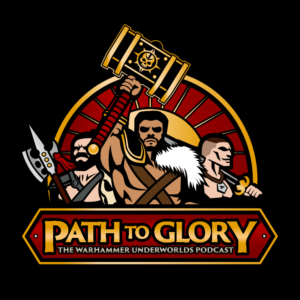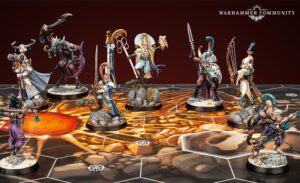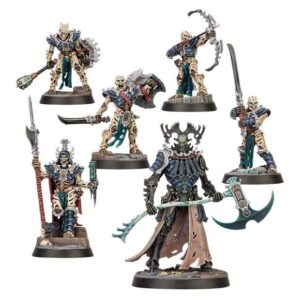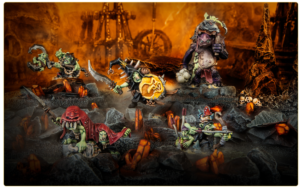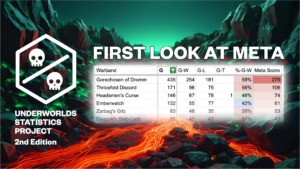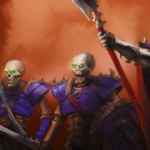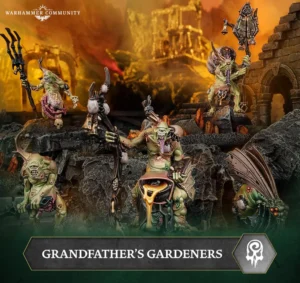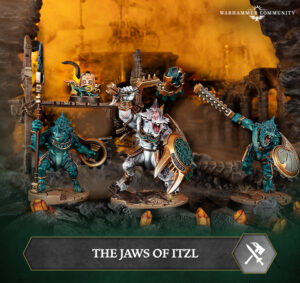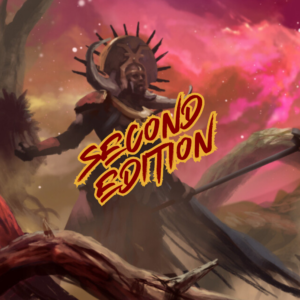Intro
Welcome back to Path to Glory! In our flurry of excitement over the new edition of the game, in this article we’ll be looking at Emberstone Sentinels. In the Embergard box, this is the “Take & Hold” deck, focusing on standing on Treasure Tokens and preventing your opponent from taking them. Previously called Hold Objective, the Take & Hold playstyle is a more positional focused way to play – rather than trying to murder your opponent’s entire Warband, you’ll be trying to stand where you need to and survive your enemy’s assault.
Emberstone Sentinels has a lot of returning favorite cards, as well as some new ones that are fairly interesting. If you haven’t played the prior edition of Warhammer Underworlds, there may be some references you’re not familiar with, but I’ll be sure to give my complete thoughts on all the cards in a way that everyone can enjoy and think about.
I’ll be grading all cards on a pretty simple scale:
S – Take this card every time, it’s so good
A – This card will likely always make the cut and be solid
B – This card is good but has some potential flaws
C – This card is pretty flawed but is good in the right circumstances
D – This card is more bad than good, but sometimes you’ll use it well
F – This card is basically terrible and you should replace it ASAP
Without further ado, let’s jump into the Objective Deck, and see how this deck likes to score. As with all new Rivals decks, it has exactly 16 Glory, so an important part will also be seeing how it is distributed.
Objectives
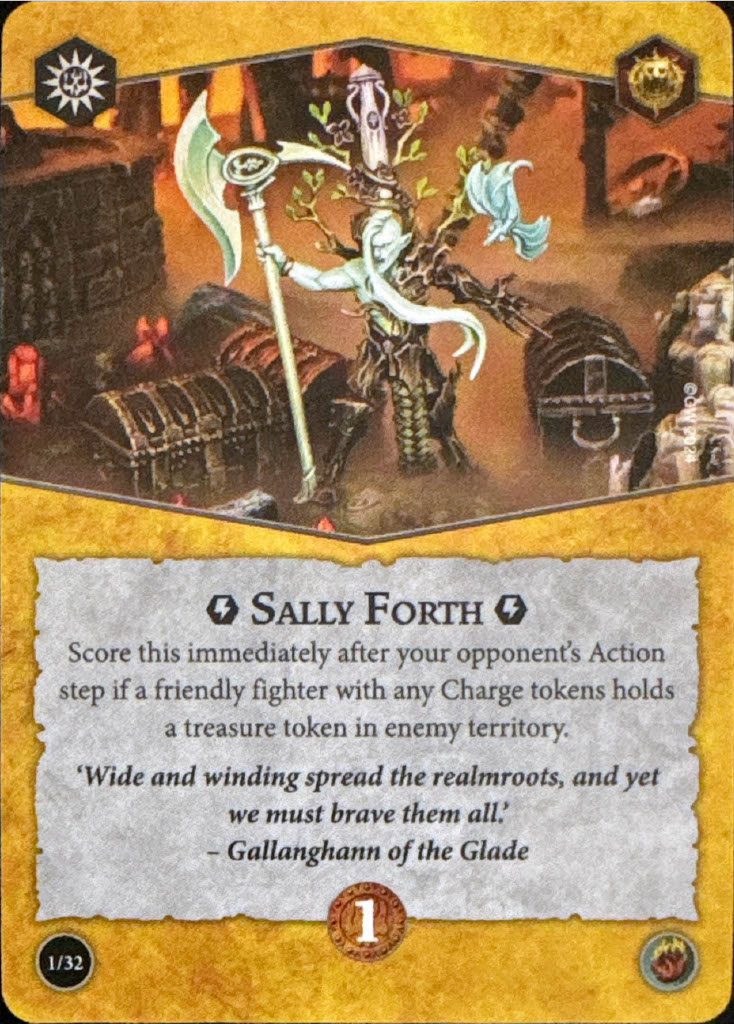
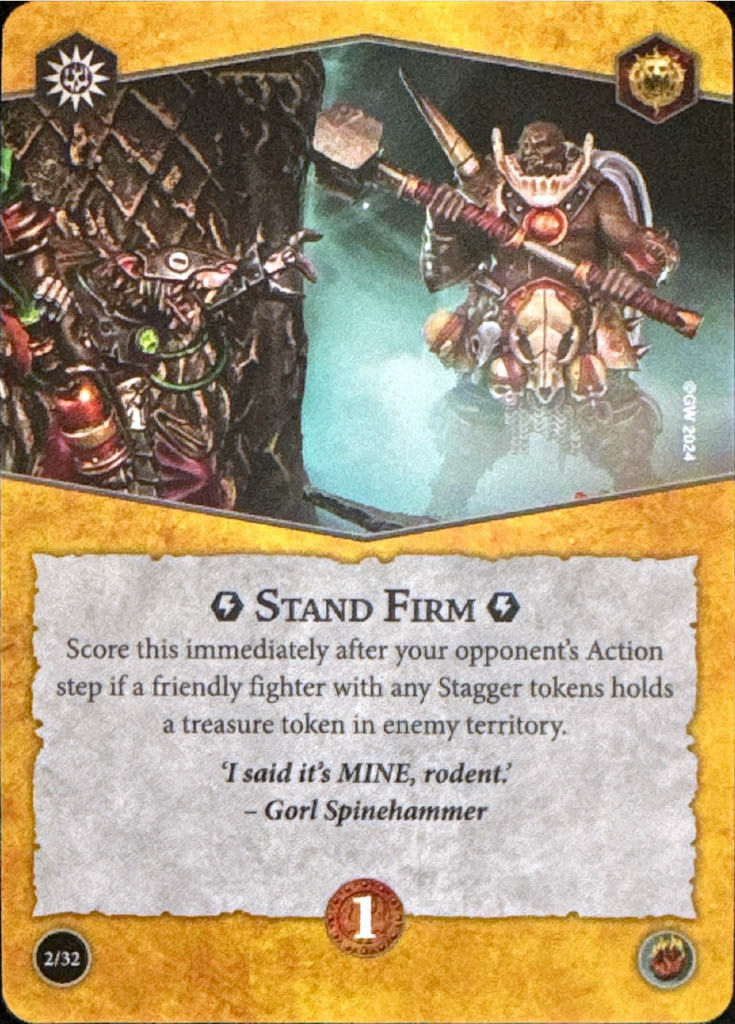
Starting off with Sally Forth, this Objective is one that is either a gimme or kind of awkward to score. That said, it’s basically never bad – Charge onto a Treasure, or have a way to give a Charge Token to someone on a Treasure, both of which you can do pretty easily. This is obviously much easier for teams with better range, as Range 1 attacks might not always have a proper target, but it’s a good first card.
A
Stand Firm is a card that you have an ok amount of control over. You can run through a Stagger Hex, you can Delve it to Cover and back again (though this will require an extra Turn or so before you can score it), or you can use certain Power cards that give your fighters Stagger Tokens. Granted, said Stagger Token makes you a more juicy target, but with some clever positioning and threat saturation, you should be able to do this fairly consistently.
B
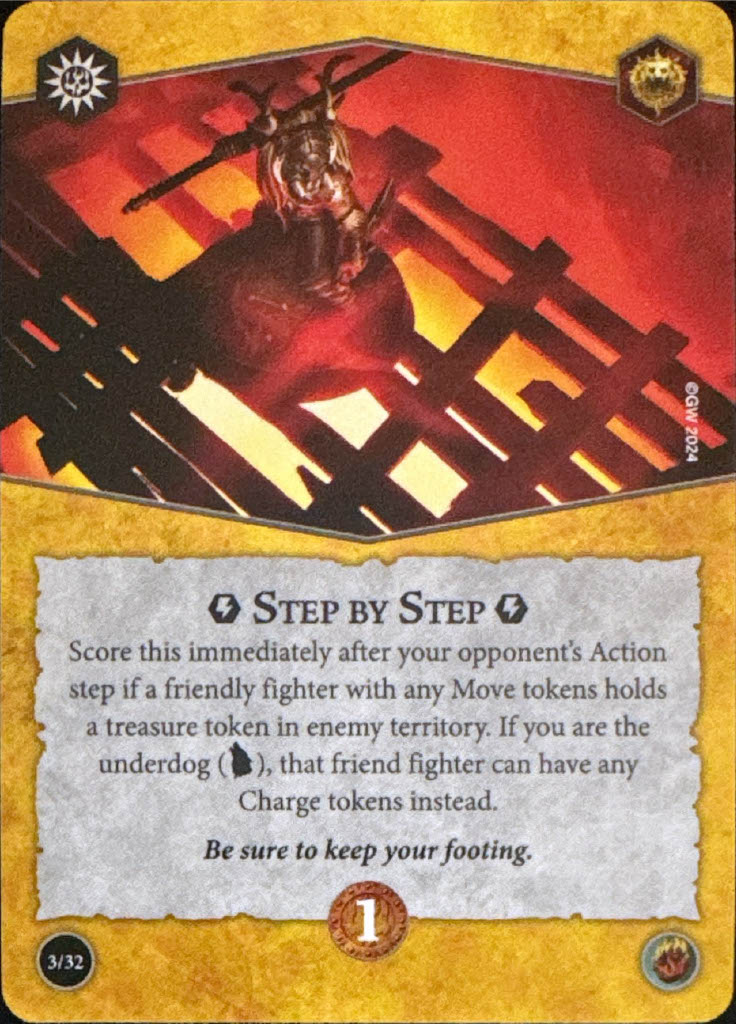
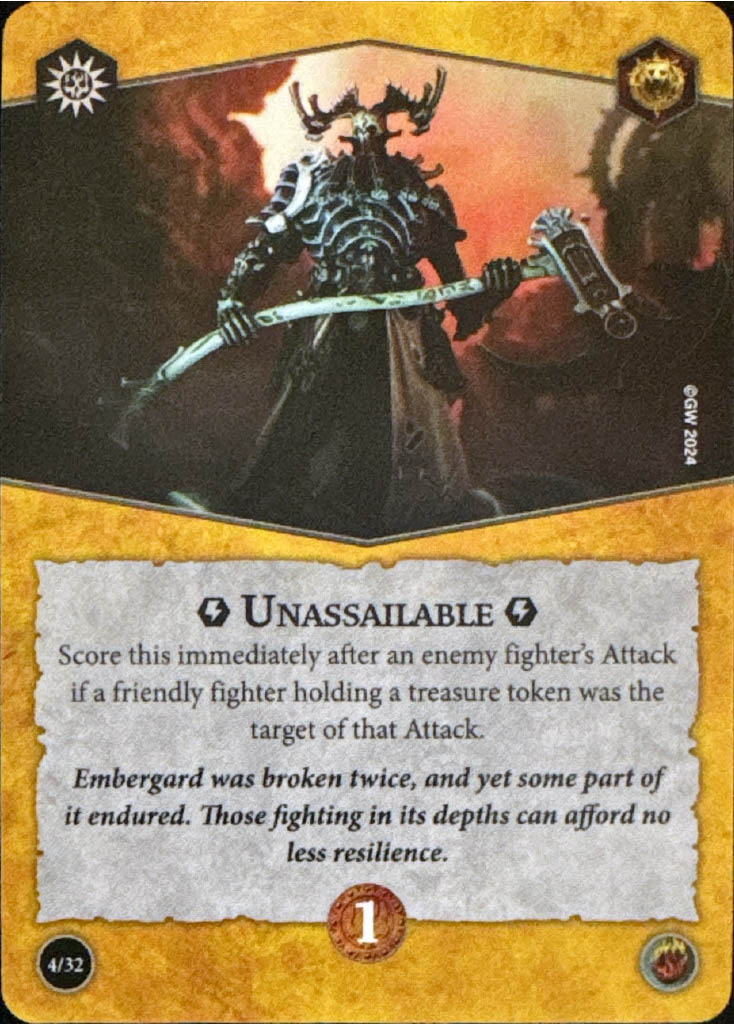
We get our first Underdog-affected card with Step By Step. This card is wildly good, in that you should basically score it any time it’s in your hand, and the Underdog bonus makes it easier. That said, sometimes you’ll end up in an awkward spot where a Fighter holding a Treasure doesn’t want to move, but you have to Move or Charge to get this scored. That’s basically the only downside, otherwise it’s excellent.
A
Keeping up the Surge train, Unassailable is also a pretty good card, but this one depends more on the warband you’re playing. Defensive or Elite warbands will love this card, especially as there’s at least a few cards in this deck that prevent driveback in one way or another. Squishy horde warbands might like it less, as those 2 Health Mooks have a tendency to explode when looked at funny. That said, dice will be dice, and sometimes you can just score this by your opponent doing what they’re going to do anyways. Sometimes, if you play against a more passive opponent or another Take & Hold deck, you might struggle to get punched, but that’s a boon in and of itself, no?
A
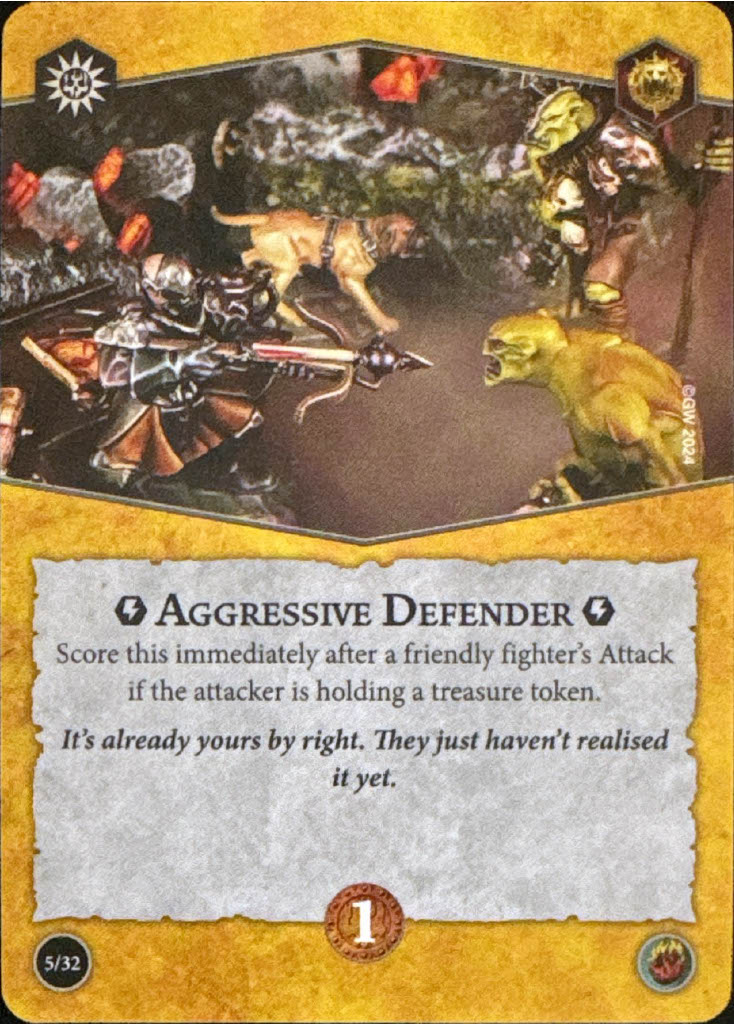
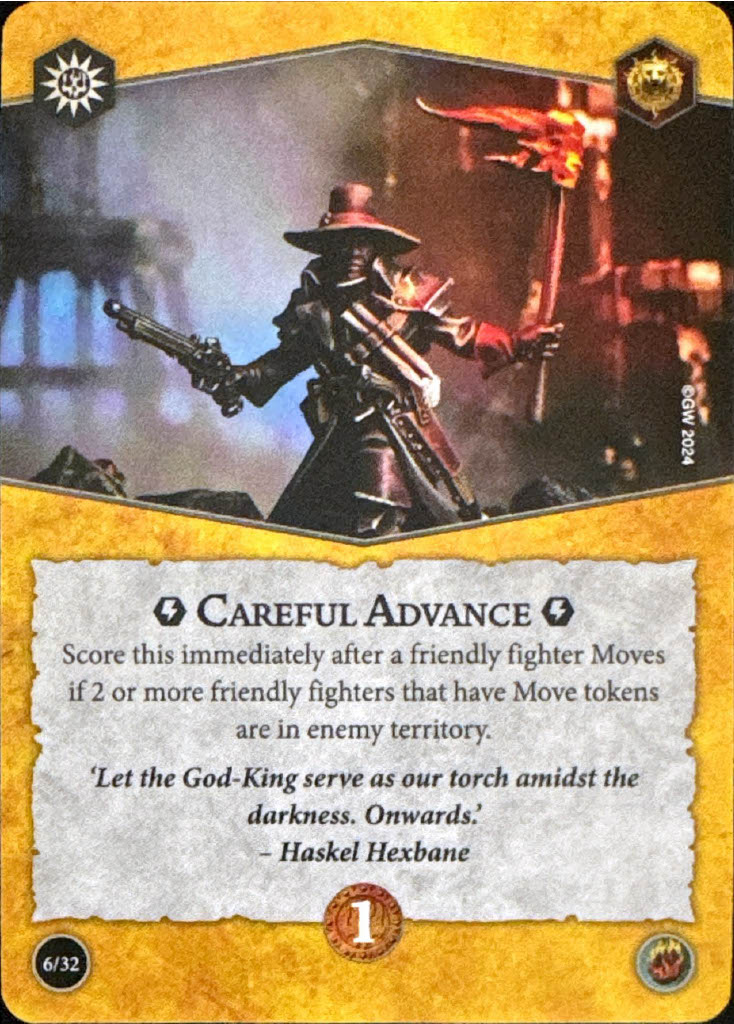
Aggressive Defender gives us the first card that actually requires an attack roll. While Sally Forth and Underdog generally want you to Charge, they can be scored in other ways. Aggressive Defender is great in that it doesn’t care about a lot of extra info. This can be done during a Charge, or while standing still on a Treasure, or potentially during a Power Step, if you have a way to make attacks out-of-sequence. As with other Attack + Position type cards, this is infinitely easier if you have Range greater than 1, and basically a gimme for Range 3+ fighters. But even for Range 1 fighters, you will probably end up fighting over Treasure, so it’s a good card.
S
Our last Objective is the only Surge that doesn’t care about Treasure Tokens. Careful Advance is one that you will often score pretty easily – after all, there’s no positional issue outside of one half of the board you want to get to already. However, this does have some counter-synergy with any cards that want you to Attack or Charge – you can’t do a simple Move and also Charge with the same fighter until you’re Charged Out, so the 4 Activation limit might make this difficult for many factions, especially when you’re trying to do multiple things at once. Still, it’s a score that requires 0 interaction with your opponent and, in the right circumstances, can be scored alongside other Surges.
B
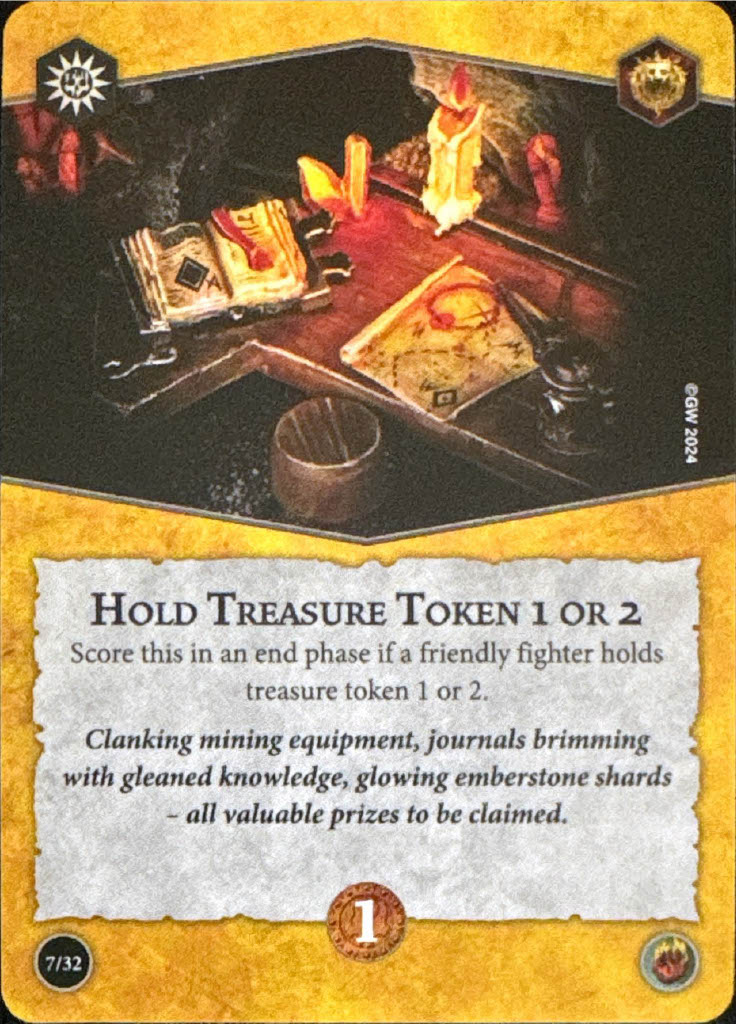
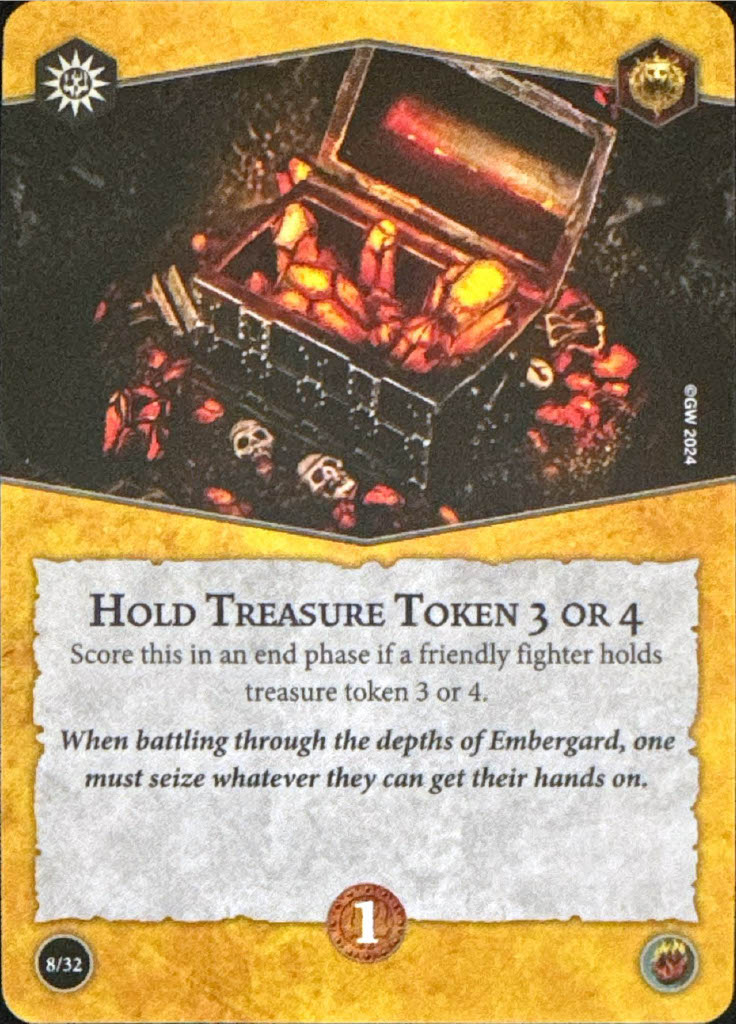
Onto End Phases, we have Hold Treasure Token 1 or 2. This is way more flexible than the old Hold Objective 1 from the prior edition of the game, and is actually not bad for a 1 Glory score. While there’s still the potential that both 1 and 2 will be on the opposite side of the board or occupied, it gives you a lot more chances for the one you want to be free. I think it’s fine, in Nemesis you might swap it out for better End Phases, but in Rivals I think you’ll do well enough with it most of the time.
B
Hold Treasure Token 3 or 4? Just read the prior card again.
B
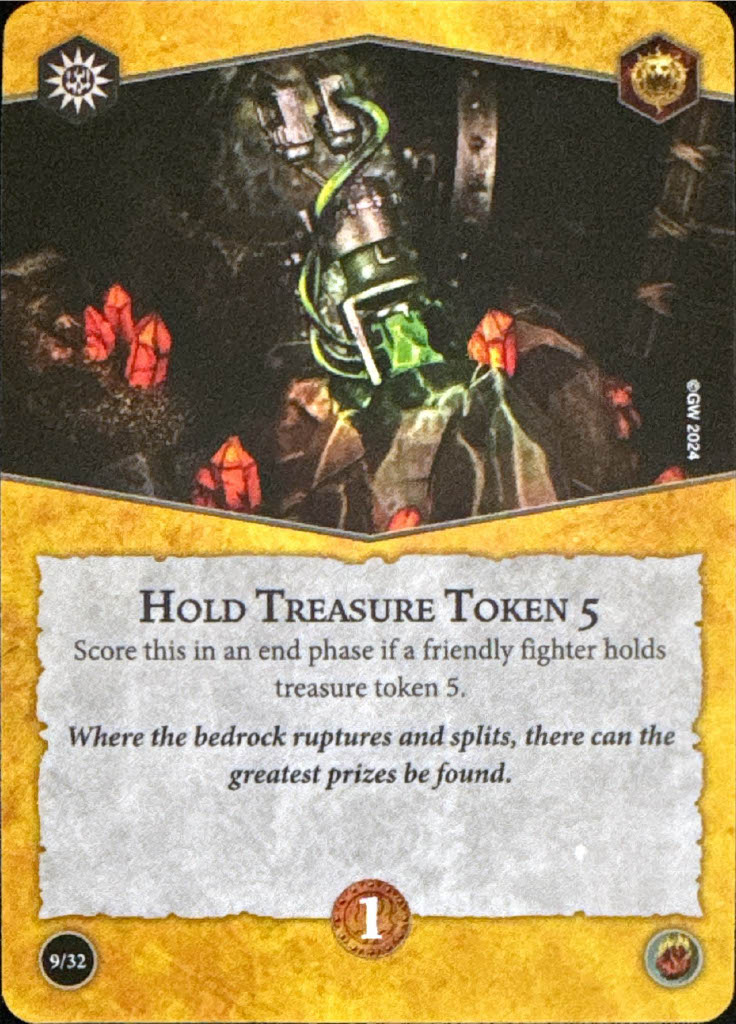

Hold Treasure Token 5 is unfortunately just a bad card. Despite the board forcing more treasure tokens to be reachable all the time, I think being forced to care about a single treasure token in particular is difficult, especially when the prior two were more flexible for the same score. It’s… ok enough in Rivals, but this is the first card I replace in Nemesis.
D
Our first card that gives multiple Glory, Slow Advance wants you to hold a neutral and enemy treasure token. This is pretty ok, but unless you’re making sure you get multiple treasure tokens in neutral territory, the middle objective will be a major point of contention. I think if you run this, you consider trying to get two in the middle and two in enemy territory if you can, but your opponent will likely be wise to this after a game or two.
B
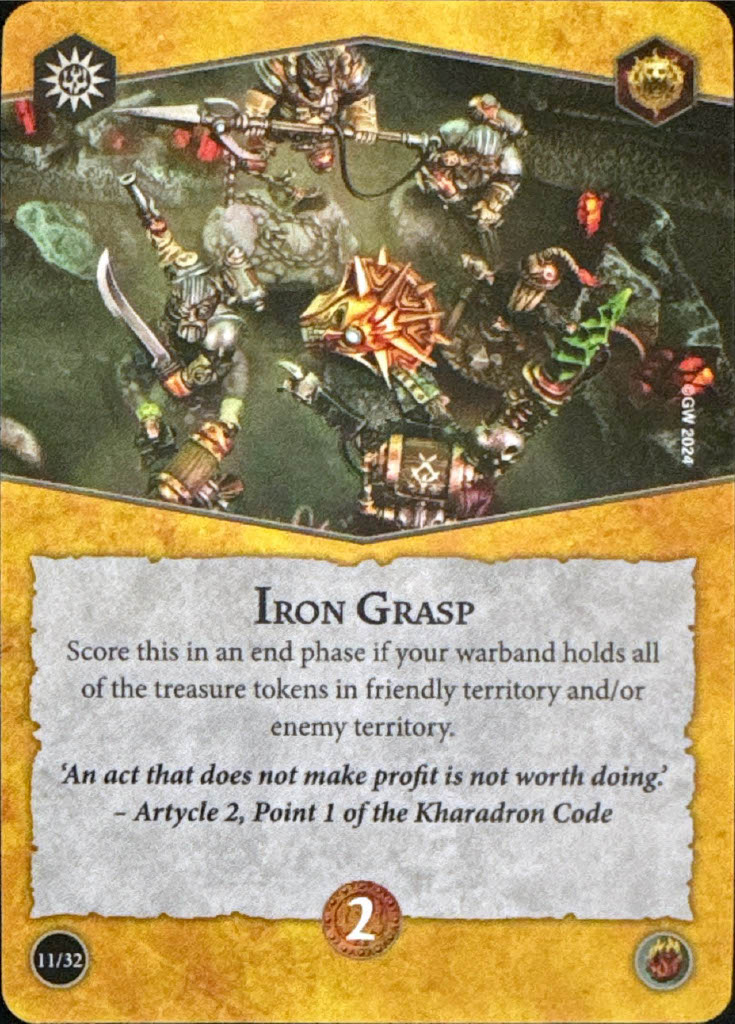

Iron Grasp is an iteration on an objective type that popped up in a few places last edition, but was almost always good. Holding all in one player’s territory is not that big of an ask, considering most of the time it’ll be 1 or 2 in a territory. If you can manage to put two in neutral Territory, this is potentially 2 Glory for holding 1 Treasure, which is great, and can be a good card for some more passive scoring by holding in your territory while you slowly build up to moving across the board. Great card, though generally pretty telegraphed to your opponent.
A
Finally we come to Supremacy, a card that is returning but in a very different form. I love this card. I think Supremacy used to be the most iconic hold objective card and I think this will continue to be an iconic Take & Hold card. Horde players will see that this is basically the same card, though a bit harder to score passively, but mid-sized warbands with 5ish Fighters will love this card. It will be really easy to score this when you have any amount of 2-Bounty fighters, as this is generally 2 Glory for any 2 Treasure, which is great. I could even see Elite warbands playing this deck just because of this card.
S
Overall I think this is a great Take & Hold objective deck! It has all the card archetypes I would include if I was trying to design a very basic T&H deck to show what the playstyle is all about, and I think there’s only one card I’m desperately trying to remove in Nemesis. While I will probably end up swapping a couple others depending on the pairing, I can easily see myself keeping 11 of these cards in a lot of games. Ploys will come next, using the same grading system.
Ploys
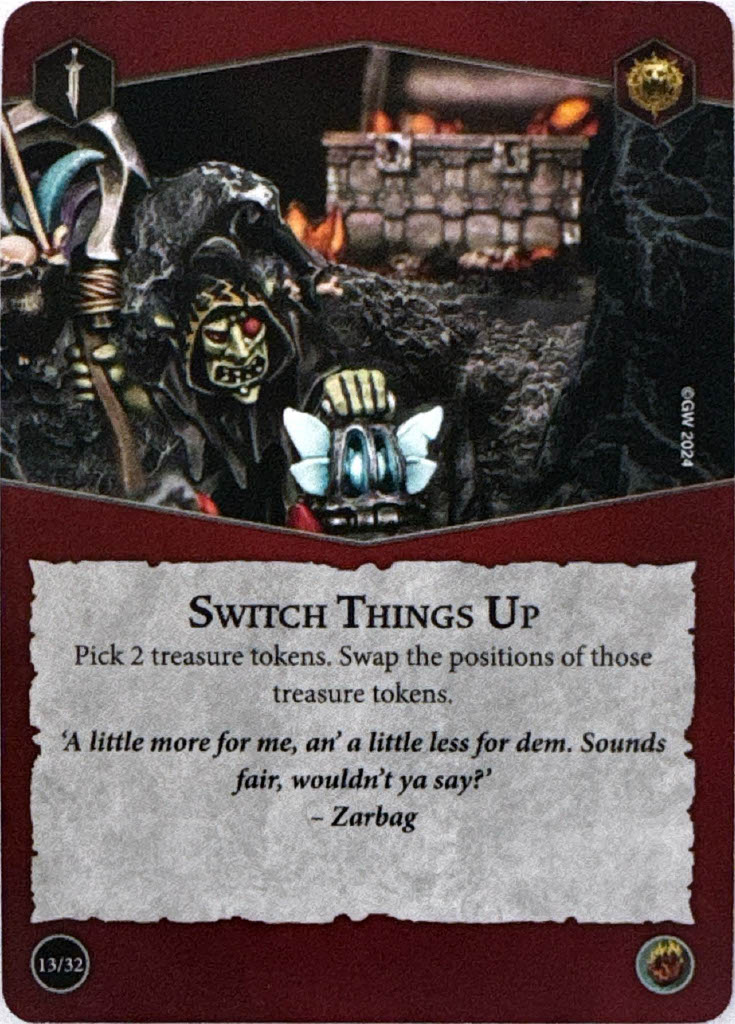
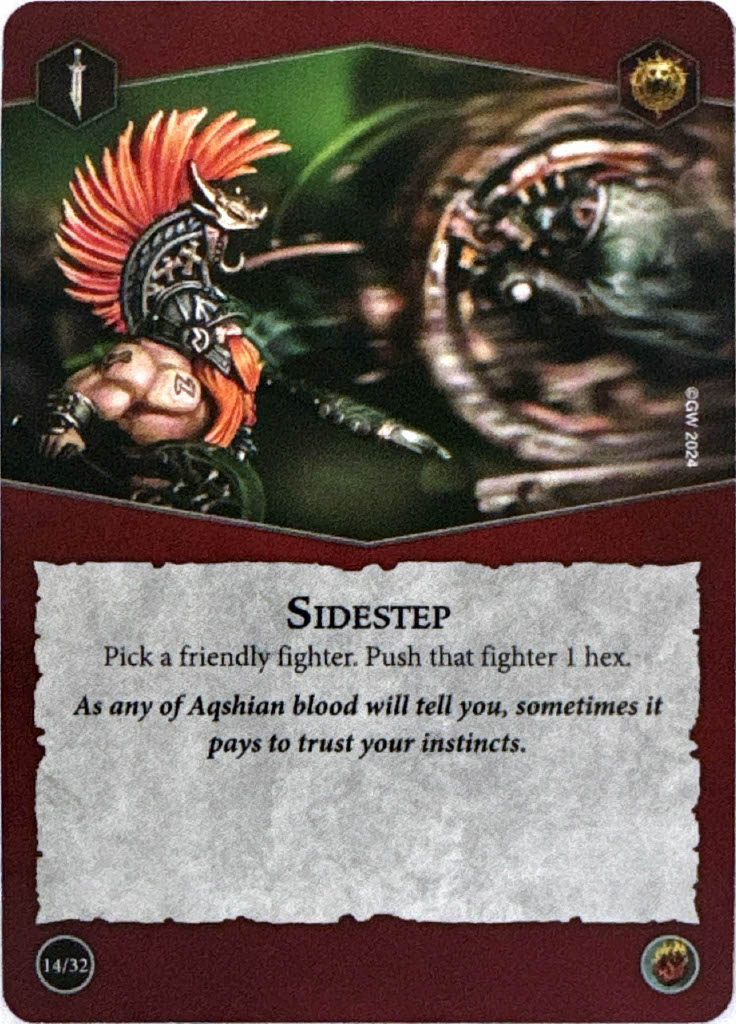
Starting off with one I’m not jazzed about, Switch Things Up is a card that really only matters for three of your Objective cards, though it does have some synergy with other Rivals decks in Nemesis. I suppose this could also give you an edge in tiebreaker scoring since treasure values matter for that, but ultimately I think there are better power cards.
C
Sidestep is a classic. Positioning is important, especially for this deck, and generic pushing outside of Action Steps is great. It’s not flashy, but it’s a workhorse that will be used in every game.
A
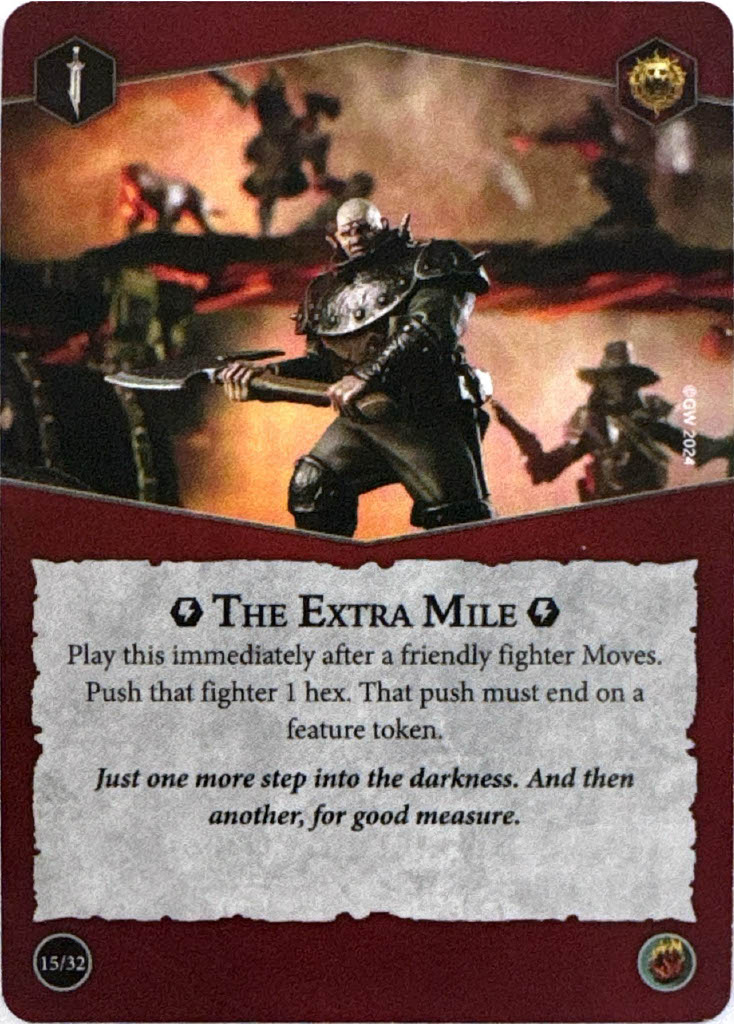
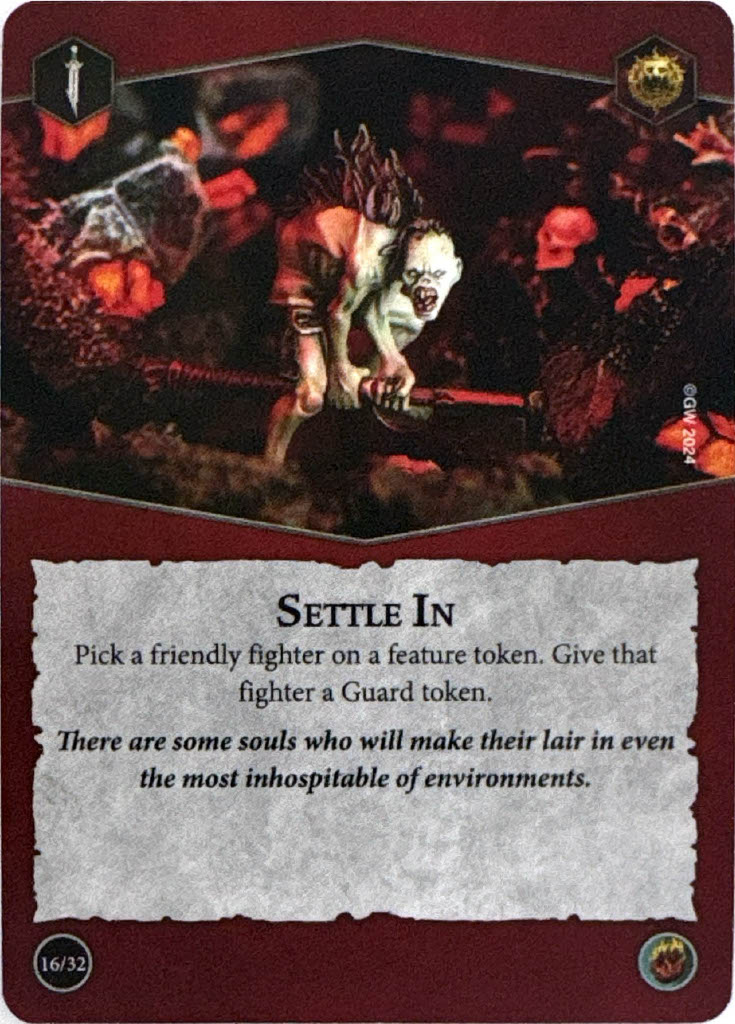
Speaking of pushes, The Extra Mile is kind of… not my favorite. This effectively amounts to +1 Move most of the time, which is great for slow Fighters and pretty underwhelming for faster ones. Will this be extremely useful in some games? Sure, but I think in other games it’ll not even get played for some teams.
C
Now we get to some synergies. Settle In gives you a Guard token, which, aside from being a solid defensive boost (especially to Dodge warbands), means you can’t be driven back from attacks. This helps you with basically every single surge in the deck (all of which score after the enemy’s Action Step) since they can’t punch you off of treasure tokens. It’s a double good twofer, especially as stagger doesn’t remove guard anymore.
A
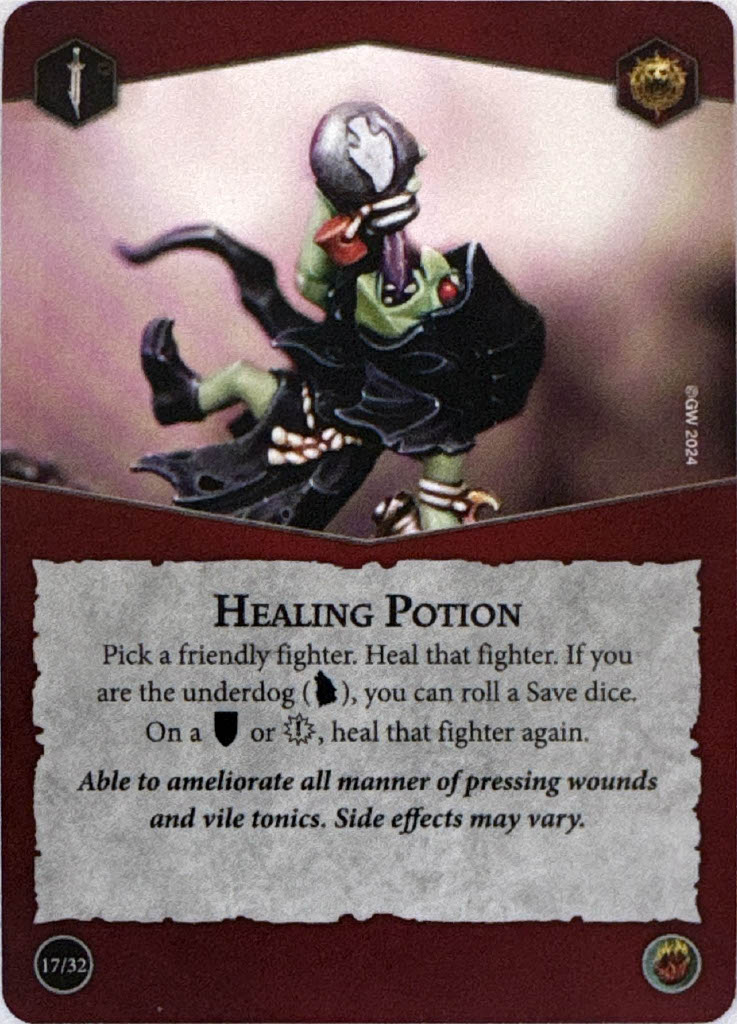
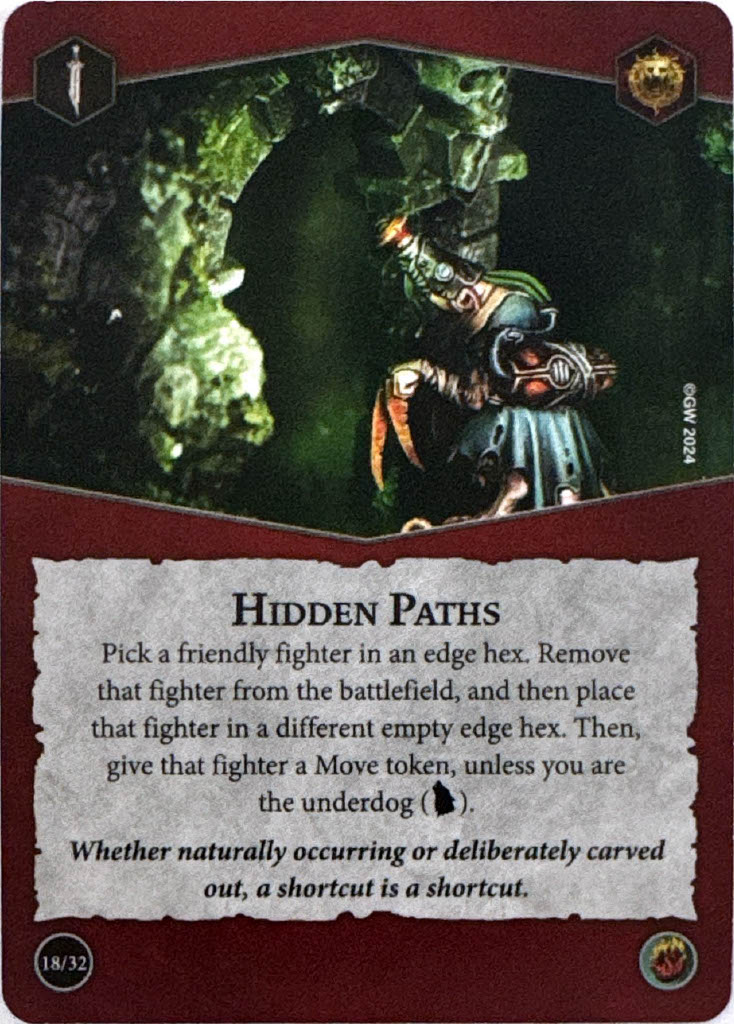
I’m having a bit of trouble evaluating Healing Potion. Heal is good – any extra Health you get is solid, but it doesn’t really help you score your cards other than not dying, sometimes. I think it’s fine, but we’ll have to see how often that heal makes a difference in practice. In prior iterations of the game, you would stack heal effects with each other and with cards that added Health, but with the change in design space, we’ll see if that sort of playstyle is still good or not.
B-
Hidden Paths is a returning card, almost unchanged except for the inclusion of the Underdog mechanic. While Hidden Paths was almost an auto-include and considered a top tier card in the prior edition, I think it’s lost a bit of luster. First, it was very popular in longboarding and offset setups of boards, when there were longer distances to cover and more edge hexes. Second, it was around when the overall speed of fighters was lower. Now with a set board that never leaves players too far apart, and lots more mid-board that’s not near edge hexes, I can see this being more limited. That said, I think a Take & Hold deck is the best type of deck for this, as you don’t necessarily care about teleporting to an attack vector, this will more be used for jumping to a treasure token that was just out of reach and snagging it. Harder to use overall, but still quite strong.
A
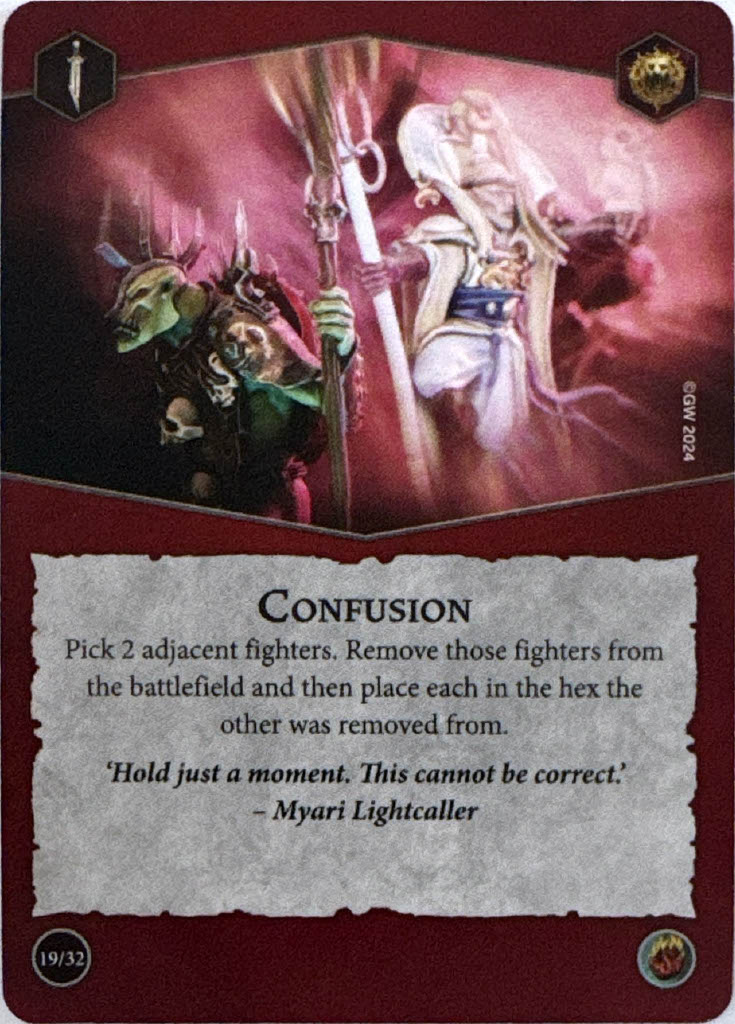
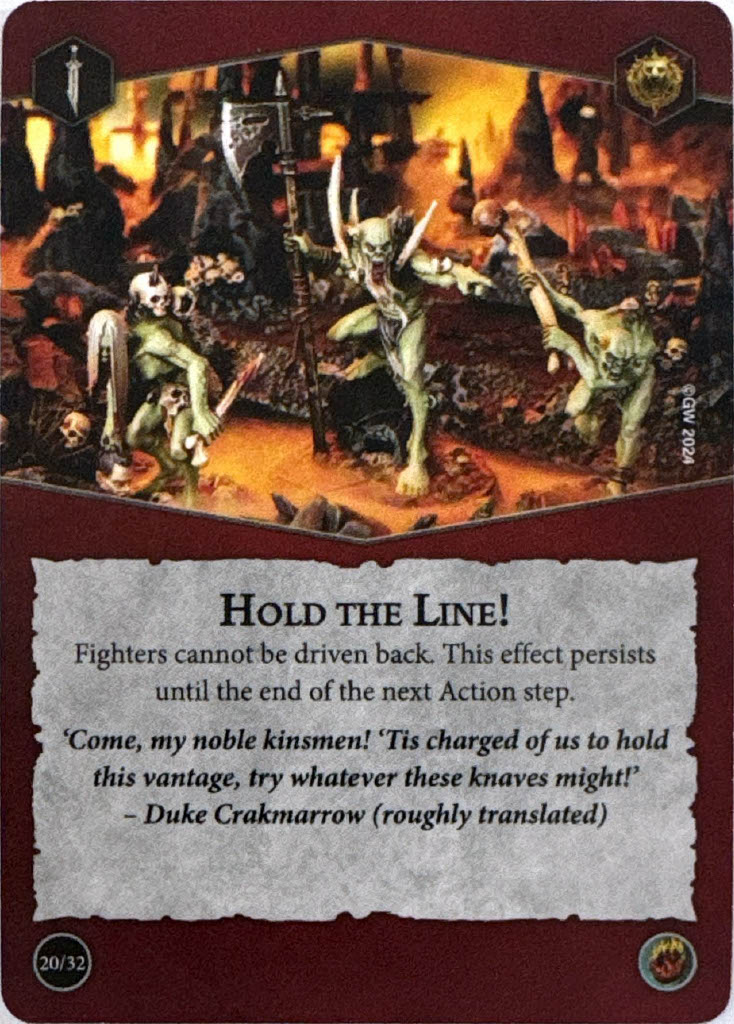
Another old staple right next to Sidestep, Confusion is another a card that won’t always be a superstar, but will always be an extremely good tool to have in your pocket. Steal a treasure token your opponent thought was safe. Set up flanked or surrounded opportunities. Get in range of something they pushed you away from. So many uses for Confusion, and all of them good.
A
Hold The Line is a bit like Settle In, except less powerful but it affects everyone. If you’re holding multiple Emberstone Sentinel Surge cards, Hold The Line will basically let you score all of them at the same time a lot of the time. Though again, it doesn’t prevent 2 Health Fighters from just exploding, nor does it stop your opponent from using Push cards, so be careful.
A
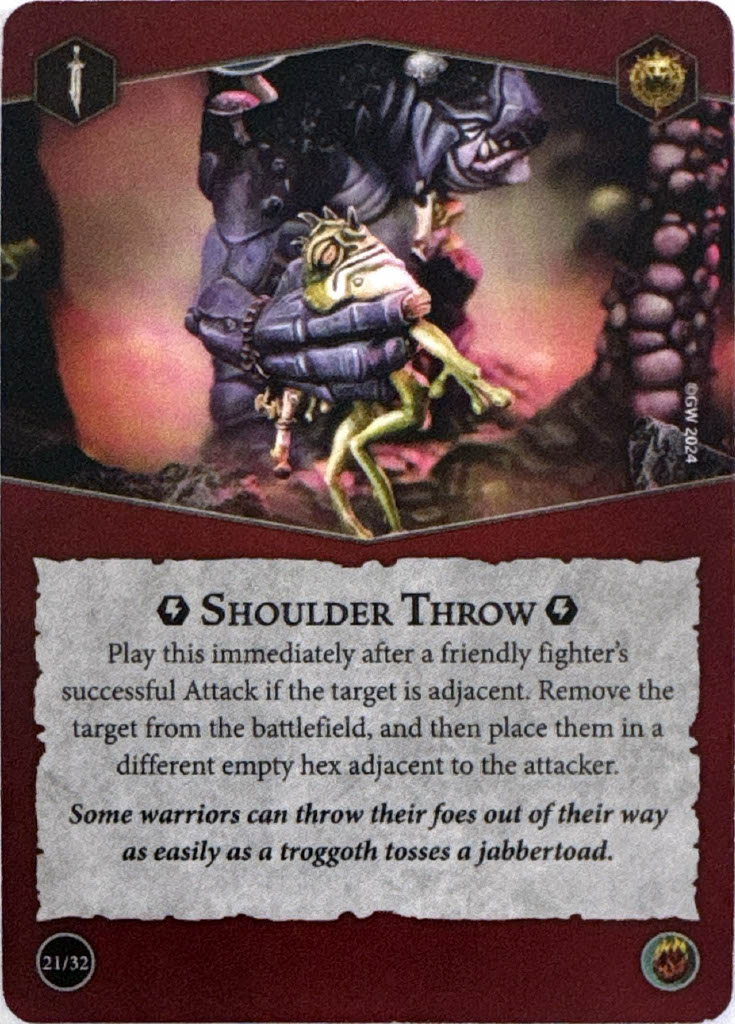
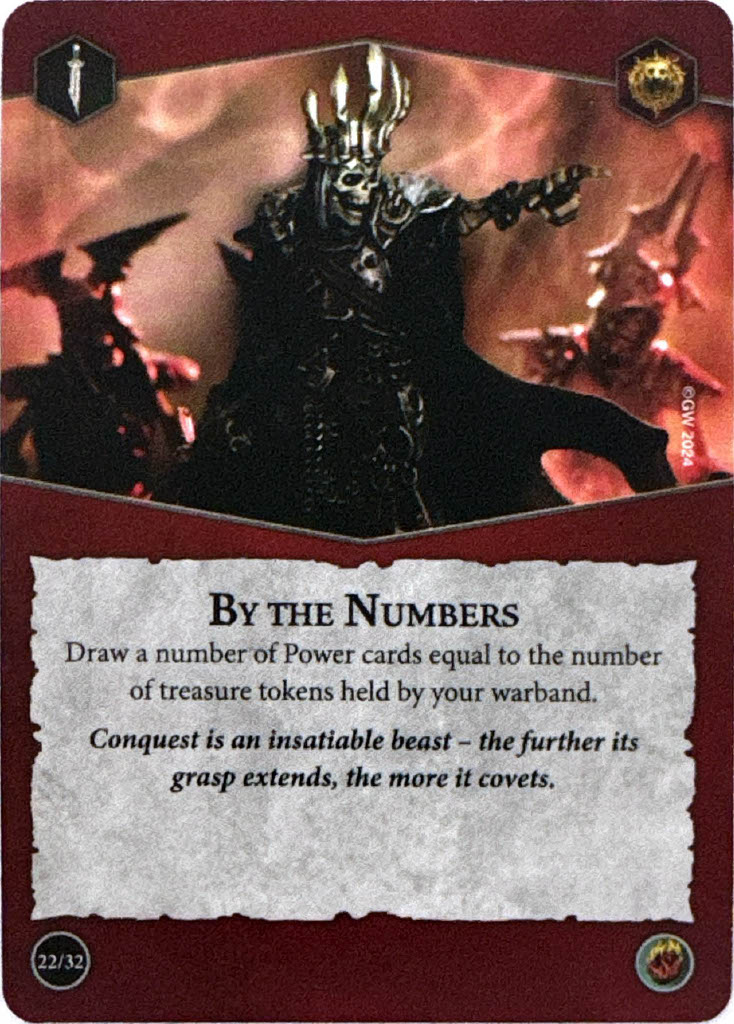
Definitely my least favorite for this deck, Shoulder Throw is a card that likely would be pretty good in an Aggro deck but here it’s a bit misplaced. Does it sometimes let you move enemy fighters on treasure that are guarded or otherwise can’t be driven back? Sure. But that’s about the only use I can see for this card, personally, and even then the attack has to be successful so for horde warbands with lots of Mook fighters, even that’s iffy. Could be good if you’re playing an Aggro deck and choose Emberstone Sentinels as your second for Nemesis, but in this deck? Meh.
D
By The Numbers is insane. Full stop. Draw 2 as a Power Card has been basically an auto-include in almost every iteration it has appeared in, and this can sometimes be Draw 3 or more with no downside other than positioning that you’re going to be doing anyways? Yeah.
S
An extremely good set of Ploys. Nothing in here is super flashy other than By The Numbers, but overall I think everything is either in line or on top of the pile for the new edition of the game, and every single one (other than Shoulder Throw) helps you achieve the goal of this deck. It’s great. Now, will the Upgrades live up as well?
Upgrades

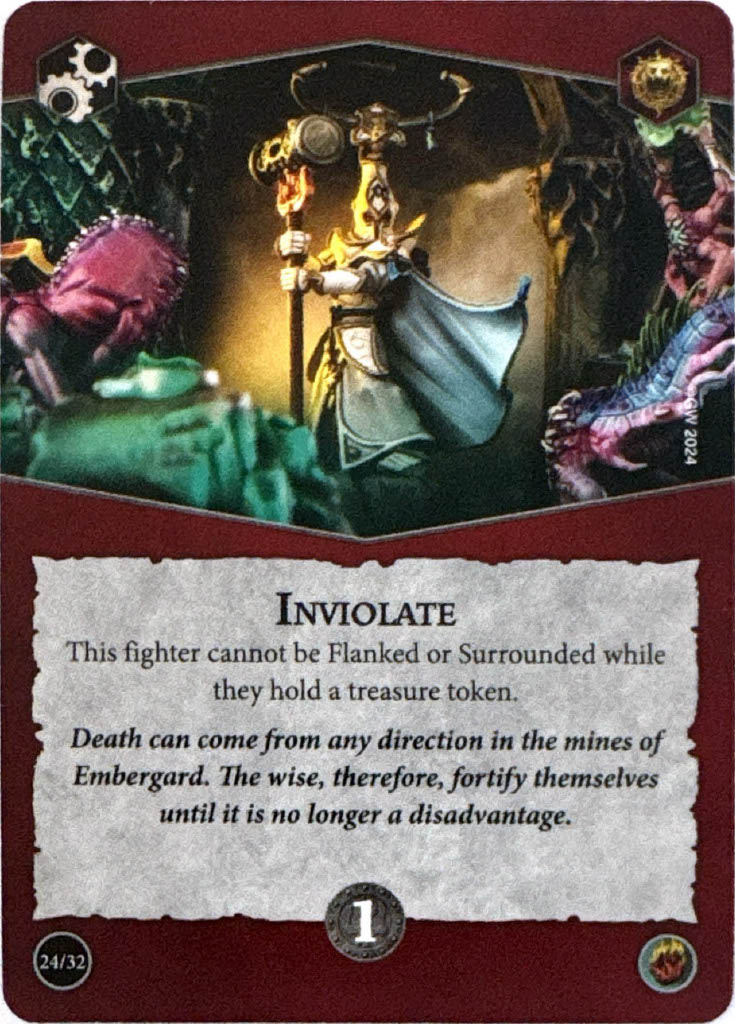
Well, Stubborn To The End isn’t amazing. This is basically to prevent your opponent from claiming a treasure they pushed you off of, or at least forces them to use a push to get it afterwards. I’m not particularly a fan. It’s fine in Rivals, but I think it’s very cuttable for Nemesis.
D
Inviolate is another one that doesn’t knock my socks off, but there’s a good amount of ways to get flanked or surrounded in these first four decks, so it at least has some solid play. That said, it rarely will matter against Elite warbands, but hey, it’s fine.
C
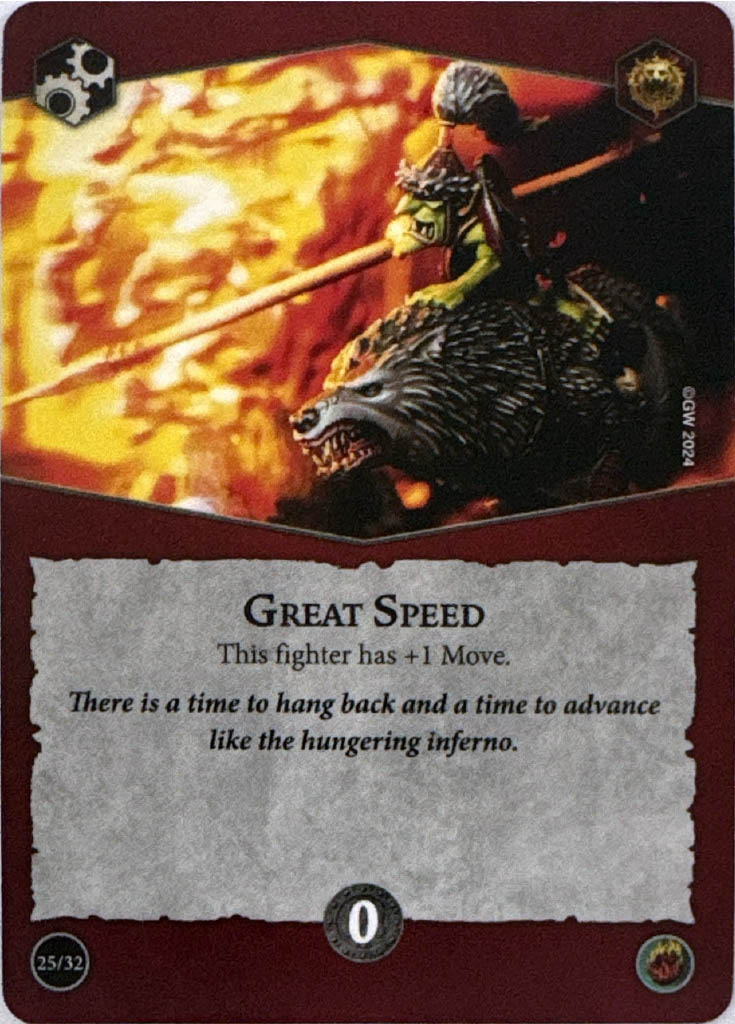

In the prior edition of Underworlds, Great Speed was a card I’d almost never take outside of very specific circumstances. Now, where it’s 0 Glory to equip? I think it’s pretty good. It’s awesome for lower Movement teams, and even for fast teams, a 0 Glory Upgrade is nice since you can get it on early and make some plays before building up your Glory pool. It’s not a crazy effect, but some warbands will absolutely love it.
B
Going from a 0 Glory Upgrade to a 2 Glory Upgrade, Sharp Reflexes is great! Well, ok, it’s not good for Warbands that already have 2 or more Save Dice, but for everyone else, I think it’s well worth the upgrade slot and 2 Glory to equip. Plus, this deck has a card that gives out Guard, which is amazing on 2-Save Fighters! Better chance to save, better chance to proc Stand Fast, just good all around.
S
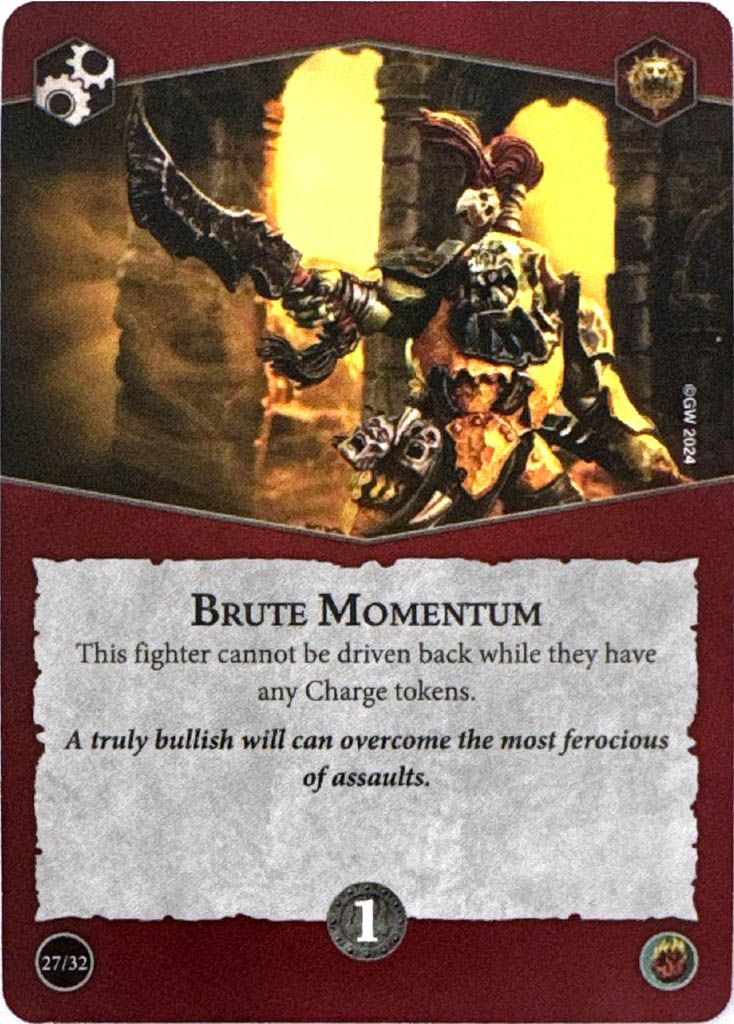
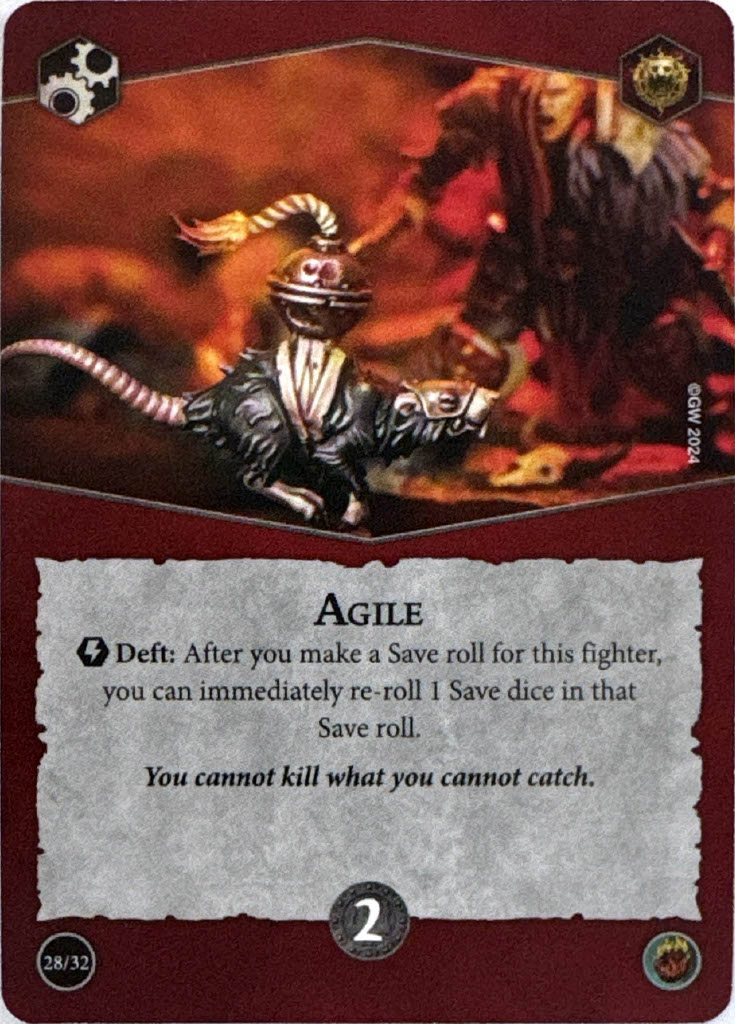
Brute Momentum is not as exciting as cards that boost your stats, but this is just another way to guarantee score your Surges and set up well for End Phases. It’s not a card I see myself bringing into other decks for Nemesis, but for Emberstone Sentinels it’s very, very good.
A
Agile is pretty comparable to Sharp Reflexes. Both have similar outcomes for a 1-Save fighter (though Sharp Reflexes is slightly better), and they stack if you throw them both on one fighter! For fighters that naturally get to 2-Save or better, this card is crazy good! Definitely worth 2 Glory to equip.
S
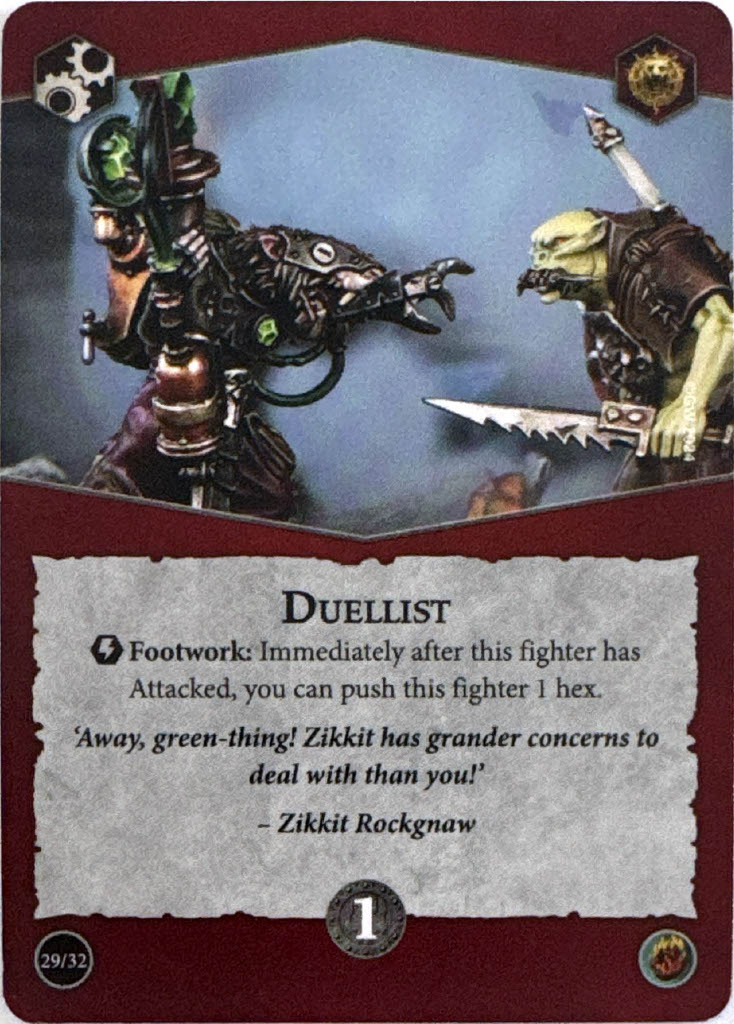
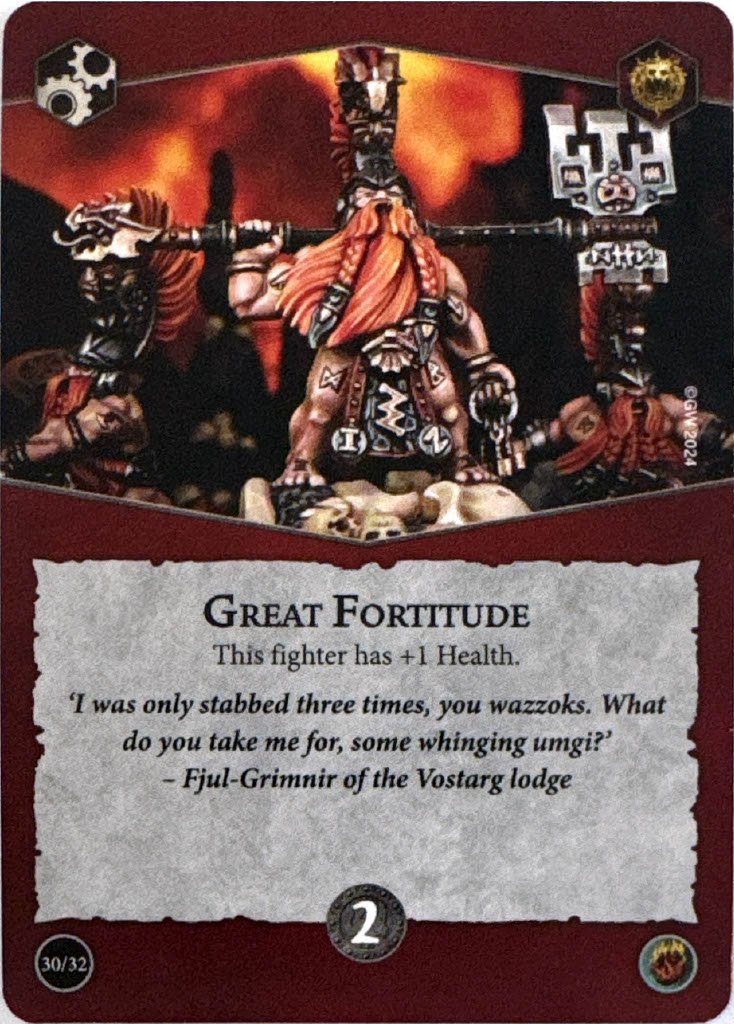
We’ve already talked about how good pushes are, and Duellist is no exception. It’s a familiar card to old hat players who played Underworlds for a long time, but in general, this card rocks. And it rocks even harder the longer range you have on your fighters. For Range 3+ fighters, this is an extremely good positioning tool that lets you poke opponents from afar while not charging and still getting movement. Even for Range 1 fighters, it’s great for charging an opponent on a treasure token and stealing it from them instead of relying on Overrun.
S
Great Fortitude has some similarities to Agile or Sharp Reflexes – they are all 2 Glory defensive Upgrades, at the very minimum. But while the other two focus on preventing or minimizing damage, Fortitude is all about accepting that damage and surviving. It combos well with heals, and increasing your Health pool has plenty of other benefits, like removing vulnerable or keeping a fighter out of one-shot range. I think this is just as good, but man, that’s a lot of 2-Glory Upgrades.
S

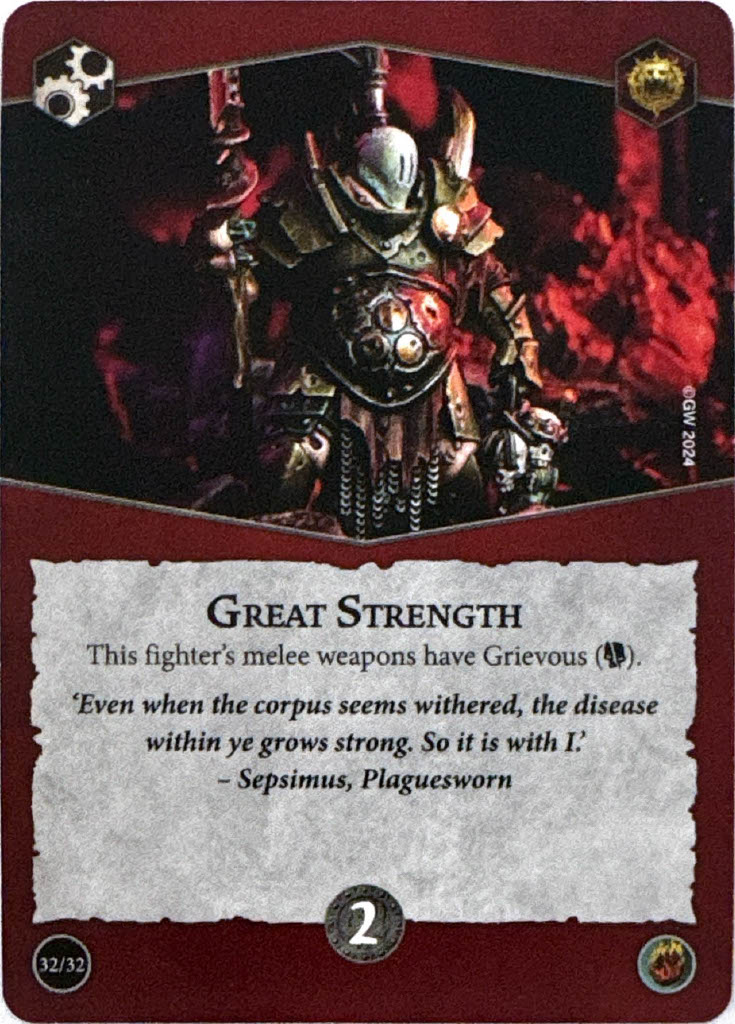
Keen Eye feels… kind of out of place? While yes, you will have to make some attacks, and accuracy is good for pushing opponent and hitting Overrun, this ultimately is not really a Strike deck, and another 2 Glory Upgrade on top of the ones you already have is kind of harsh. This is a great card to bring into a Strike or Flex deck, and still fine (though expensive) for this deck, but I’m not crazy about it for the Take & Hold gameplan.
B
A lot of what I said about Keen Eye is how I feel about Great Strength. Is it good? Of course, more damage is great. But we’re not really trying to kill things. Oh of course, killing is good for Bounty and removal and board dominance, but there’s probably Upgrades out there to bring into Nemesis that will facilitate your gameplan better. Still, though, it’s a damage boost so it’s not bad.
B
Conclusion
Now, people may accuse me of being biased towards loving Take & Hold as a playstyle. And those people would be right, I think it’s the most fun way to play. But in my opinion, this is the type of deck I’d make if I was making a generic Take & Hold deck for a box set. And because of that, I love Emberstone Sentinels. I don’t think there’s that many stinker cards in here, and the gameplan actually works in terms of snagging treasure tokens. I’m excited to try this with a variety of warbands – fast teams like Spiteclaw, horde teams like Grymwatch, or even midsize ranged teams like Profiteers or Pandemonium all seem like they’d be really interesting to pair with this deck.
However, we have one more thing to consider, and that’s how you pair this deck with the other Rivals decks in Embergard when you go to play Nemesis. Nemesis is the main competitive game mode, and it’s the one I think most people end up playing. Embergard comes with three other decks, each one a different Archetype, so none of them make a straight up Take & Hold pair. For more info on these decks, I would recommend reading our other articles on them on our site, or listening to our Podcasts.
For now, I’ll give my quick thoughts. These are viewed from the standpoint of wanting to play a Take & Hold style of play, and using the other deck to supplement that:
Blazing Assault: Being the Strike deck means it doesn’t vibe as well with Emberstone Sentinels just in general, but it’s a possibility to make work. This pair’s objective deck would lean a bit more towards Charging and attacking from treasure tokens, and therefore would likely be best for Range 2+ Warbands, perhaps dropping Stand Firm or Careful Advance for some of the more dice-focused attack surges. Profiteers or Pandemonium could consider this, for example, but even more elite warbands like Farstriders as well.
As for ploys, there’s a few extra cards for gaining mobility, guard tokens, or enemy pushes, all of which help you claim tokens. These will be more impactful against other Take & Hold warbands, though I think they’ll be a bit less important against enemy Strike warbands who will likely still out-brawl you. Still, if you need speed and positioning, there’s some ok picks.
In the upgrades, there a lot of duplicates and other accuracy buffs, none of which helps for holding treasure tokens. Tough is likely the best Upgrade to pick up here, but even that depends heavily on the team you’re taking and how much aggro you expect to see in your games.
Overall, I think this pairing can be good if you expect to see other Take & Hold style decks, or even into Pillage and Plunder, as it’ll help you jockey for position on treasure tokens, but ultimately you’re not much better at actually holding those than the base Rivals deck.
Countdown to Cataclysm: The first Mastery deck, this one is a bit odd, but I actually think there’s some good synergies here. First, in the plot card, you move the tracker for each feature token your opponent isn’t on. Take & Hold puts your fighters on those tokens, which synergizes very well! The objective deck also curiously has at least one really good Take & Hold style card in Set Explosives, and at least one extremely good end phase to replace Hold Treasure 5 with Spread Havoc. Given that the Emberstone Sentinels surges are all fairly good, you don’t really need any of the surges here, which is good since they don’t super mesh that well.
The ploy cards here have some funky controlling cards that mess with your opponent and also give you a burst of Inspiration, but overall nothing here helps you hold treasure tokens. It may help you survive by messing with your opponent, though, which is nice sometimes.
Cataclysm’s upgrades have an interesting setup. Utter Conviction and Driven By Pain both give you cheaper, but more fiddly, defensive tools than the ones you have, and Burnt Out gives you another draw card that can combo with By The Numbers to draw most of your deck (and potentially score Stand Firm). Hurled Weapon can help you poke from a distance while still holding treasure tokens, so I think there’s a good number of upgrades to mess with here.
This is probably my favorite pairing out of the box, in terms of Take & Hold gameplay. It loses some of the brawling power from Blazing Assault, but picks up utility and some cool T&H scoring.
Pillage and Plunder: The final deck in the box is marked as Flex, but the core concept in this deck is delving. Many of the objectives are focused around delving tokens, which at the surface has some anti-synergy with Take & Hold, but there’s potential for something interesting here.
First, the objectives give you some more reliable and flexible 1-Glory End Phases in Lost In The Depths, Against the Odds, and Desolate Homeland. Whether these are better than Hold 1-2 or Hold 3-4 is arguable, but they do give you some ways to score outside of holding. Delving for Wealth and Claim the Prize both can be scored alongside Emberstone Sentinel Surges, though it’ll require some serious flipping back and forth. But Share The Load is an insanely good card for Sentinels in general, so there’s some good stuff here.
The PnP ploy set is kind of varied and interesting, but there’s some extra push, some guard tech, and even a teleport that isn’t as good as Hidden Paths but can give you more teleporting prowess, which is cool.
The upgrades here bring two ok weapons (especially for your horde warbands with bad baseline attacks), some more teleporting in Canny Sapper, and some more defense in Impossibly Quick among others.
I’m actually not crazy about this pairing. There’s an oddball playstyle here where you get onto tokens, constantly flip them back and forth, and find a balance between cover and treasure in the end phase for maximum scoring, but I personally think it’s less interesting than the other two.
I myself will be trying the Emberstone Sentinels + Countdown to Cataclysm pairing, but I’m excited to see what the community comes up with too, and how things will work with future decks!
To wrap up the article, I’m very excited for this deck as I think it appeals to my personal playstyle and includes a lot of cards I find fun and exciting! Let us know down below in the comments what warbands you’re excited to make into Sentinels, or what pairings you think are cool. Until next time, we wish you the best of luck on YOUR Path to Glory!
